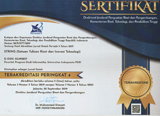Pengukuran Kinerja Operasional Perusahaan Meubel Berdasarkan Konsep Green Manufacturing untuk Mewujudkan Keberlanjutan Proses
(1) Institut Teknologi Adhi Tama Surabaya
(2) Institut Teknologi Adhi Tama Surabaya
(*) Corresponding Author
Abstract
The rapid development of the industrial sector encourages the emergence of environmental issues, especially the global warming. The phenomenon occurs because of many factors. The most common factor is the manufacturing industry which mostly utilizes natural resources and non-renewable energy. In an observation made on Meuble Company XXX, there are flaws in waste management during its production process. Scattered wooden wastes are visible in the production area and there are no major attempts to reduce the production process’ impact on surrounding air pollution. Based on the observation, this research attempts to determine Meuble Company XXX’s operational capability based on indicators of Green Manufacturing in accordance with The Organization for Economic Co-operation and Development’s (OECD). The research result indicates two indicators, namely waste intensity and air pollution intensity need further evaluation that the company can apply the green manufacturing concept better. The result also shows there are 6 indicators with null score, meaning the company does not use natural resources or non-renewable energy during those processes and there is no negative impact on the environmentt. Based on results, it can be concluded that the operational performance of Company Meuble XXX on Green Manufacturing is in Advance category.
Keywords
Full Text:
PDFReferences
F. C. Gunawan, “Analisis Green Manufacturing Pada Idea Mebel Semarang,” Skripsi, Universitas Katholik Soegijapranata Semarang, 2021.
S. Boubaker and A. Omri, “How does renewable energy contribute to the growth versus environment debate?,” Resour. Policy, vol. 79, 2022.
D. Ajie, “Analisis Level Green Manufacturing Pada Analisis Level,” Skripsi, Unika Soegijapranata Semarang, 2020.
D. Dornfeld, Green manufacturing: Fundamentals and applications, vol. 9781441960. Springer US, 2013.
M. A. A. Rehman and R. L. Shrivastava, “Green manufacturing (GM): Past, present and future(a state of art review),” World Rev. Sci. Technol. Sustain. Dev., vol. 10, no. 1–3, pp. 17–55, 2013.
R. Amaranti et al., “Green Manufacturing : Kajian Literatur,” Semin. dan Konf. Nas. IDEC, vol. 8, no. 9, pp. 2579–6429, 2017.
OECD, “OECD sustainable manufacturing tookit - seven steps to environmental excellence,” p. 54, 2011.
M. Shahzad, Y. Qu, S. U. Rehman, and A. U. Zafar, “Adoption of green innovation technology to accelerate sustainable development among manufacturing industry,” J. Innov. Knowl., vol. 7, no. 4, p. 100231, 2022.
F. Li, T. Zhang, Q. Sha, X. Pei, Y. Song, and C. Li, “Green Reformation of Chinese Traditional Manufacturing Industry: Approach and Potential for Cooperation,” Procedia Manuf., vol. 43, no. 2019, pp. 285–292, 2020.
D. Hariyani and S. Mishra, “Cleaner and Circular Bioeconomy Structural Equation Modeling of Drivers for the Adoption of an Integrated Sustainable-Green-Lean-Six Sigma-Agile Manufacturing System ( ISGLSAMS ) in Indian Manufacturing Organizations,” Clean. Circ. Bioeconomy, vol. 4, no. December 2022, p. 100037, 2023.
E. Yuliawati, Pratikto, Sugiono, and O. Novareza, “Measuring The Reverse Logistics Performance Of Construction Machinery Remanufacturing Company,” J. Southwest Jiatong Univ., vol. 55, no. June, 2020.
DOI: http://dx.doi.org/10.30998/string.v8i1.16382
Refbacks
- There are currently no refbacks.
Copyright (c) 2023 Evi - Yuliawati, Septian Dwi Prasetyo

This work is licensed under a Creative Commons Attribution 4.0 International License.
STRING (Satuan Tulisan Riset dan Inovasi Teknologi) indexed by:

Ciptaan disebarluaskan di bawah Lisensi Creative Commons Atribusi 4.0 Internasional.
View My Stats


 Sertifikat Akreditasi
Sertifikat Akreditasi
















